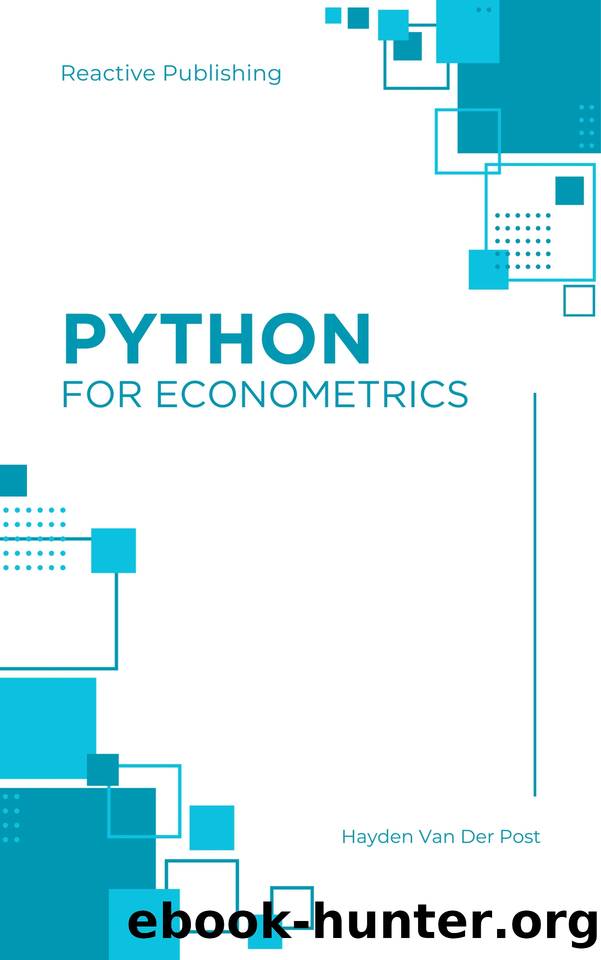Python for Econometrics: Bridging Data Science and Economic Analysis: A comprehensive guide to Python for Econometrics by Van Der Post Hayden

Author:Van Der Post, Hayden
Language: eng
Format: epub
Publisher: Reactive Publishing
Published: 2023-10-20T00:00:00+00:00
Model Diagnostics and Extensions
In our journey through Python in econometrics, we've learned about various advanced econometric techniques, from instrumental variable (IV) regression to limited dependent variable models. Now, as we delve deeper into the intricacies of econometric analysis, we arrive at the critical stage of model diagnostics and extensions. In this chapter section, we explore the essential elements of model diagnostics, focusing on two significant aspects: heteroscedasticity and serial correlation tests. These diagnostic tools serve as the guiding lights to ensure the robustness and reliability of our econometric models.
Heteroscedasticity: Understanding Variance Disparities
Heteroscedasticity, a mouthful of a term, is a fundamental issue in econometrics. It refers to the situation where the variance of errors in a regression model is not constant across all values of the independent variables. In simple terms, it means that the spread of residuals (the differences between observed and predicted values) varies as you move along the range of the predictors.
Why is this a problem? Well, it can lead to biased and inefficient parameter estimates, affecting the validity of your model. It could also give a false impression of statistical significance. To tackle this issue, we employ diagnostic tests like the Breusch-Pagan and White tests, both of which are available in Python libraries like statsmodels.
To apply these tests, you need to understand the underlying principle. The null hypothesis for both tests assumes homoscedasticity, meaning constant variance. If the p-value associated with the test is small (typically below 0.05), you can reject this null hypothesis, suggesting the presence of heteroscedasticity. In such a scenario, you may consider transformations or robust standard errors to address the issue.
Now, let's see a Python example of how to perform these tests and deal with heteroscedasticity.
python
import statsmodels.api as sm
from statsmodels.compat import lzip
from statsmodels.stats.diagnostic import het_breuschpagan, het_white
# Fit your regression model
model = sm.OLS(y, X).fit()
# Apply Breusch-Pagan test
bp_test = het_breuschpagan(model.resid, model.model.exog)
lzip(, bp_test)
# Apply White test
white_test = het_white(model.resid, model.model.exog)
lzip(, white_test)
Serial Correlation: Dealing with Auto-correlation
Serial correlation, often known as autocorrelation, is another concern in econometrics, particularly in time series analysis. It arises when the residuals of a model are correlated with each other. In simpler terms, it means that the error terms at one time point are dependent on the errors at a previous time point. This can violate the assumption of independent errors, potentially rendering our parameter estimates inefficient and biased.
To detect serial correlation, we employ tests like the Durbin-Watson test and the Ljung-Box test. If these tests indicate the presence of serial correlation, it's essential to address the issue. In time series data, this is typically achieved through differencing or including lagged values of the dependent variable in the model.
Now, let's take a look at how to apply these tests in Python:
python
from statsmodels.stats.stattools import durbin_watson
from statsmodels.stats.diagnostic import acorr_ljungbox
# Calculate Durbin-Watson statistic
durbin_watson_stat = durbin_watson(model.resid)
# Perform the Ljung-Box test for serial correlation
lb_test_stat, lb_p_value = acorr_ljungbox(model.resid)
We've explored the critical aspects of model diagnostics, focusing on heteroscedasticity and serial correlation tests. By mastering these tools and applying them correctly, you can ensure the validity and reliability of your econometric models.
Download
This site does not store any files on its server. We only index and link to content provided by other sites. Please contact the content providers to delete copyright contents if any and email us, we'll remove relevant links or contents immediately.
International Integration of the Brazilian Economy by Elias C. Grivoyannis(99042)
The Radium Girls by Kate Moore(11975)
Turbulence by E. J. Noyes(7980)
Nudge - Improving Decisions about Health, Wealth, and Happiness by Thaler Sunstein(7659)
The Black Swan by Nassim Nicholas Taleb(7058)
Rich Dad Poor Dad by Robert T. Kiyosaki(6514)
Pioneering Portfolio Management by David F. Swensen(6257)
Man-made Catastrophes and Risk Information Concealment by Dmitry Chernov & Didier Sornette(5957)
Zero to One by Peter Thiel(5735)
Secrecy World by Jake Bernstein(4701)
Millionaire: The Philanderer, Gambler, and Duelist Who Invented Modern Finance by Janet Gleeson(4425)
The Age of Surveillance Capitalism by Shoshana Zuboff(4247)
Skin in the Game by Nassim Nicholas Taleb(4205)
Bullshit Jobs by David Graeber(4141)
The Money Culture by Michael Lewis(4135)
Skin in the Game: Hidden Asymmetries in Daily Life by Nassim Nicholas Taleb(3962)
The Dhandho Investor by Mohnish Pabrai(3725)
The Wisdom of Finance by Mihir Desai(3696)
Blockchain Basics by Daniel Drescher(3541)
